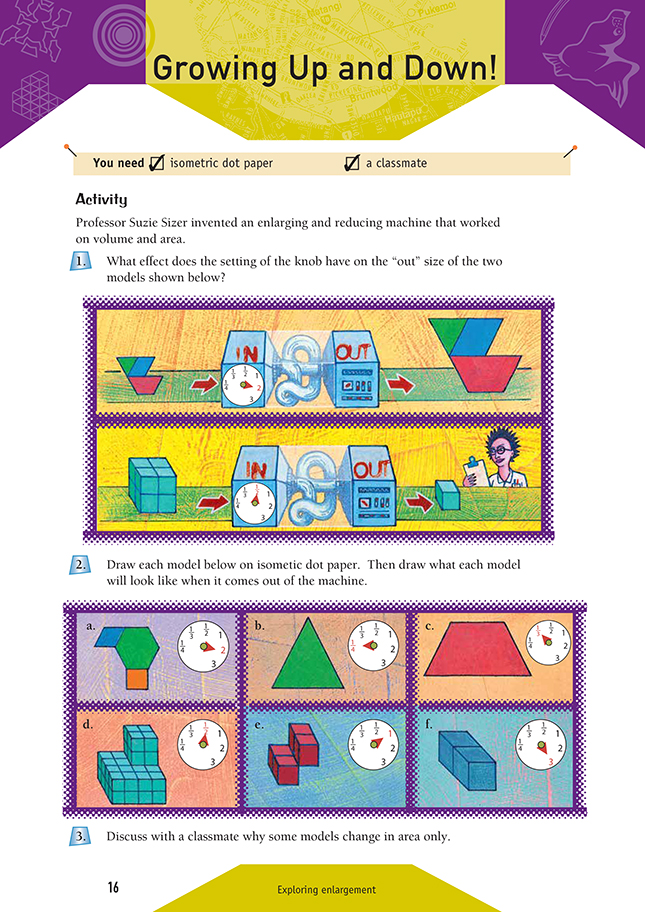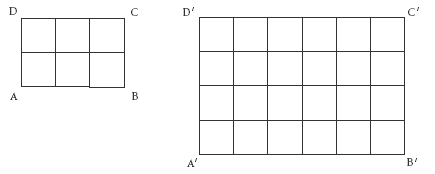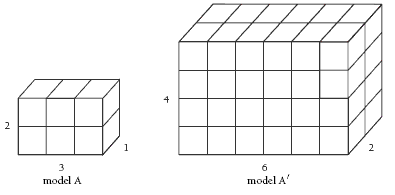This is a level 4 geometry strand activity from the Figure It Out series.
A PDF of the student activity is included.
Click on the image to enlarge it. Click again to close. Download PDF (263 KB)
explore the properties of shapes under enlargement
Copymaster of isometric dot paper
FIO, Level 3-4, Geometry, Growing Up and Down!, page 16
classmate
This activity further develops students’ understanding of enlargement. It builds on earlier activities on pages 23 and 24 of Geometry, Figure It Out, Level 3, where students use a grid method to enlarge pictures by a scale factor of 2.
In this activity, students use a variety of scale factors, namely 2, 1/2, 1/4, 3, 1/3, and 1. A scale factor of 1 means that the image stays the same as the original. The key understanding reinforced by this activity is that the image (the enlarged shape) has the same proportions as the original.
Question 1 gives the students an example of an enlargement and a reduction. In the first example, the knob is on 2, so the side length of one unit is multiplied by 2. In the second example, the knob is on 1/2. The original is two units, and 2 x 1/2 = 1. This is a good opportunity to reinforce that dividing a unit by 2 is the same as multiplying it by 1/2.
In question 2, the students are given original images and their scale factors and have to work out the relevant enlargement or reduction. In each case, encourage them to focus on multiplying by the figure on the knob before they draw their models.
The students can check their answers by considering whether reversing the process would give the original image. Students who are having difficulty with this activity may also find grid paper useful. Pattern blocks are also useful for modelling the enlargements and reductions. Have the students begin by modelling the enlargement shown in question 1 so that they understand how to use the pattern blocks to enlarge or reduce.
An alternative way of considering enlargement problems is: given the image and scale factor, what does the original look like? For example, if a model has been reduced by 1/3, what does it need to be multiplied by to get it back to its original size?
As an extension, you could give the students some original images and enlargements or reductions of these images and then ask the students to find the scale factor. The key aspects of enlargement that the students should understand are:
• The scale factor of an enlargement is the factor by which the length of an object is increased.
• The scale factor can be found by taking the ratio of the length of a side of an enlarged or
reduced image to the length of the corresponding side on the original image.
• When a 2-dimensional shape is enlarged by a scale factor of 2, the area is increased by a factor of 22 (or 4).
• When a 3-dimensional shape is enlarged by a scale factor of 2, the volume is increased by a factor of 23 (or 8).
Rectangle ABCD is enlarged by a scale factor of 2. The length of each side is multiplied by 2.
The area of the rectangle has increased from 6 square units to 24 square units.
Model A is enlarged by a scale factor of 2. The volume of the model has increased from 6 cubic units to 48 cubic units.
Answers to Activity
1. The knob setting says what to multiply each side of the shape by. Every side of the first shape is enlarged by 2 and every side of the second shape is reduced by half.
2.
3. Answers will vary. Two-dimensional models can only change in area. Three-dimensional models can change in both area and volume.



